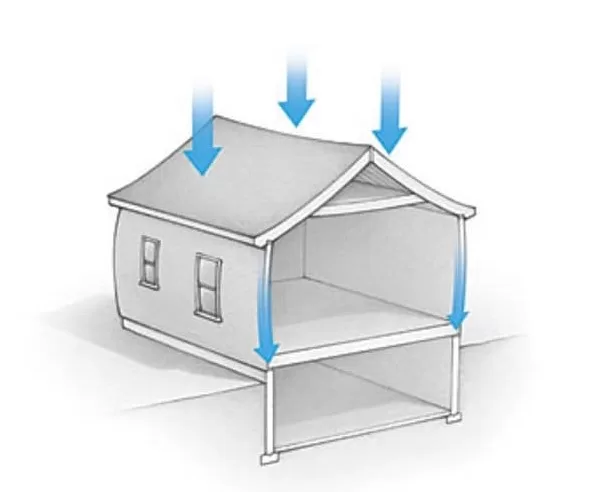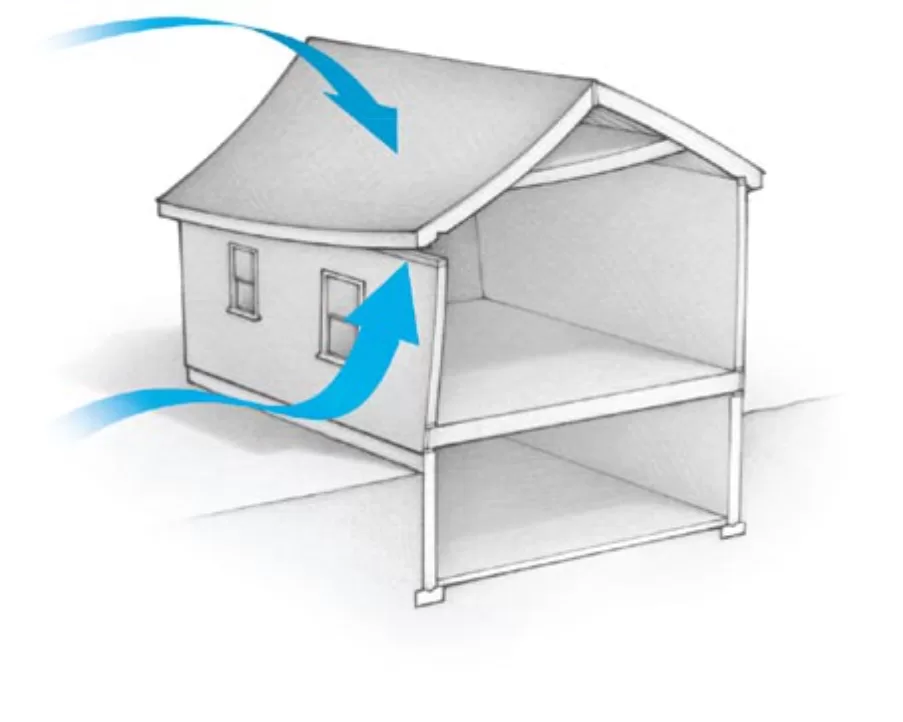A structural load refers to the application of forces, deformations, or accelerations onto elements within a structure. Such loads induce stress, deformations, and displacements within the structure. Within the realm of engineering, structural analysis examines how these loads impact structures and their components. It is vital to control and account for loads during the design phase, as excessive loading can lead to structural failure. Various load types can initiate stress, displacement, and deformation within a structure, ultimately leading to structural concerns or even outright failure. Accurately calculating the cumulative load on a structure is an intricate and essential process.
Types of loads
Loads on buildings and structures can be categorized into vertical, horizontal, and longitudinal types. Vertical loads encompass dead load, live load, and impact load. Horizontal loads comprise wind load and earthquake load. In specific design scenarios, longitudinal loads, such as tractive and braking forces, are taken into account. Accurate calculation of these diverse loads is crucial. Design standards like the Indian standard code IS: 875–1987 and the American Standard Code ASCE 7: Minimum Design Loads for Buildings and Other Structures provide guidelines for these loads. The following sections delve into each type of load.
Dead Load
Dead load refers to the inherent weight of permanent components within a structure. It encompasses elements such as walls, floors, roofs, columns, beams, and any other stationary elements. In engineering, accurately calculating the dead load is crucial as it forms the foundation for designing all load-bearing components. Engineers consider the density, dimensions, and configurations of various materials to determine the precise weight of each element.
Dead load remains constant over time and plays a significant role in determining the structural stability and integrity of a building. It serves as the basis for calculating the overall load-bearing capacity of structural members, helping prevent excessive deflection, deformation, or failure. Proper assessment and distribution of dead load ensure that the structure can adequately support its own weight without compromising safety. By accounting for dead load, engineers create designs that can withstand the intrinsic forces acting within the structure, forming a solid foundation for further load considerations.

Live Load
Live load, also known as “occupancy load,” encompasses transient and variable loads on a structure due to occupants, furniture, equipment, and movable loads. In architectural and engineering design, live loads are crucial factors as they represent the dynamic nature of structures’ usage. Residential spaces face live loads from people, furniture, appliances, and activities, while commercial and industrial spaces accommodate loads from machinery, occupants, and storage.
Structural engineers determine live loads by following building codes and standards, accounting for worst-case scenarios to ensure safety. Live load values are specified based on the type of space and its intended usage. For example, a classroom’s live load might differ from that of a warehouse. Engineers analyze the distribution of live loads to ensure that structural members, such as beams, columns, and floors, can sustain these transient loads without failure or excessive deflection.
Structural design considers the potential for concentrated live loads, such as heavy equipment or machinery, which may result in localized stresses. Balancing the weight-bearing capacity of a structure with live load demands is crucial to prevent damage or compromise to the integrity of the building. As live loads can change over time due to occupant behavior or alterations, designers often incorporate safety factors to ensure the structure’s longevity and resilience against varying loads.

Wind Load
Wind load is the lateral force exerted by wind on a structure’s surfaces, which can lead to structural movement and even failure if not adequately accounted for in design. It is a critical consideration, especially for tall buildings and structures with large surface areas exposed to wind.
The magnitude of wind load depends on factors like the building’s height, shape, orientation, wind speed, and the local topography. Structural engineers use wind tunnel testing, computational fluid dynamics, and wind pressure coefficients to determine the wind loads on different parts of a structure.
The American Society of Civil Engineers (ASCE) provides guidelines for calculating wind loads in their “ASCE 7-16 Standard: Minimum Design Loads and Associated Criteria for Buildings and Other Structures.” These guidelines consider various factors such as the building’s exposure category, importance level, and dynamic response characteristics.
To withstand wind loads, designers reinforce structural members and connections. Cross-bracing, shear walls, and other lateral load-resisting systems are incorporated to ensure stability. Wind load analysis and design ensure that structures remain safe and stable under varying wind conditions, preventing damage or potential collapse due to wind-induced forces.

Snow Load
Snow load is a significant consideration in regions experiencing cold climates. It refers to the weight of accumulated snow on roofs and other surfaces of structures. The magnitude of snow load depends on factors such as snow density, local climate, roof pitch, and the potential for drifting. Engineers estimate snow load to ensure that roofs can safely support the additional weight without collapsing.
Design codes and standards provide guidelines for calculating snow loads based on geographic location and building characteristics. These standards consider factors like the ground snow load, roof shape, and thermal conditions that affect snow accumulation and melt. Snow load calculations involve determining the total load on the roof and distributing it to individual structural members.
In regions with heavy snowfall, snow load mitigation strategies include designing roofs with steeper pitches to shed snow, reinforcing roof structures to bear greater loads, and using materials that resist the accumulation of snow and ice. Proper management of snow load is crucial to prevent structural damage, ensure occupant safety, and maintain the longevity of buildings in cold-climate areas.

Earthquake Load
Earthquake load, a crucial consideration in seismic regions, is the lateral force generated by the movement of the Earth’s crust during an earthquake. This dynamic force subjects structures to lateral acceleration, causing stress and deformation. Engineers assess earthquake loads by considering factors like the structure’s mass, stiffness, damping, and the ground’s response spectrum.
Seismic design codes and regulations guide engineers in determining the appropriate level of earthquake load for a specific location. Designing for earthquake loads involves ensuring structures can withstand the anticipated seismic forces without collapse or severe damage. Engineers employ techniques such as base isolation, damping systems, and ductile detailing to enhance a structure’s seismic performance.
The complexity of earthquake loads lies in their unpredictability and potential for high-intensity shaking. Structural analysis methods, including static and dynamic analyses, help engineers understand the potential impact of earthquakes on structures. By accurately calculating and accommodating earthquake loads, engineers enhance the resilience of buildings and infrastructure, safeguarding lives and minimizing damage during seismic events.

Temperature Load
Temperature load, arising from thermal expansion and contraction, affects structures as temperatures fluctuate. Different materials expand and contract at varying rates when exposed to temperature changes. This leads to stress and strain within structural components. In hot conditions, materials expand, while in cold conditions, they contract. If not accounted for, temperature-induced forces can cause deformation, cracking, or even structural failure.
Engineers consider the coefficient of thermal expansion of materials to predict how much they will expand or contract due to temperature changes. Expansion joints, gaps, and proper detailing help accommodate these movements without compromising structural integrity. Thermal load analysis becomes critical in structures with long spans, high-rise buildings, and bridges where temperature differentials are more pronounced.
Materials like concrete, steel, and composite materials are chosen based on their thermal properties. Careful detailing and material selection mitigate the impact of temperature load. In regions with extreme temperature variations, such as deserts or polar areas, temperature load assessment becomes even more crucial to ensure the long-term durability and functionality of structures.

Fluid Pressure Load
Fluid pressure load arises in structures containing or restraining fluids, like dams and tanks. It’s the result of the fluid’s weight and hydrostatic pressure. Structural engineers calculate this load to ensure the integrity of these structures against potential leaks, deformations, or failures. By accounting for fluid density, height, and pressure, designers ensure that the structure can withstand the forces exerted by the contained fluid without compromising safety or stability. Proper consideration of fluid pressure loads is critical for preventing catastrophic failures and ensuring the long-term performance of fluid-containing structures.

Dynamic Load
Dynamic loads arise from moving elements like vehicles and machinery, causing vibrations and oscillations in structures. These loads are transient and often have varying magnitudes and frequencies. Structural engineers analyze dynamic loads to prevent resonance and structural damage. Calculations involve evaluating load frequency, amplitude, and impact, and employ techniques like damping and vibration isolation to minimize vibrations and ensure the stability and integrity of structures during dynamic events.
Impact Load
Impact load refers to sudden, high-intensity forces resulting from collisions or impacts. Common in scenarios like vehicles hitting structures or heavy objects falling, impact loads can lead to localized stress concentrations. Engineers design structures to withstand these dynamic forces by reinforcing vulnerable areas, utilizing impact-absorbing materials, or employing energy-absorbing mechanisms. By accounting for impact loads, structural integrity is maintained, preventing potential damage, deformation, or failure.
Soil Load
Soil load refers to the weight of soil or backfill material above a foundation or retaining structure. It exerts downward pressure on the foundation, affecting its stability. Engineers assess factors such as soil type, density, and moisture content to determine the load’s magnitude. The depth of soil and its properties impact the load distribution. Adequate design accounts for soil load to ensure that foundations can support both the structure’s weight and the load imposed by the soil, preventing excessive settlement or structural failure.

Conclusion
Comprehending and accurately assessing various types of loads on structures is paramount for designing safe, stable, and resilient constructions. Each load type, whether dead, live, snow, wind, earthquake, temperature, fluid pressure, dynamic, impact, or soil load, brings unique challenges that structural engineers must address. By applying meticulous calculations, rigorous analysis, and adherence to established standards, engineers ensure that buildings and structures can withstand diverse environmental conditions and loading scenarios. Striking the right balance between load-bearing capacity and structural integrity safeguards lives, property, and the longevity of our built environment. Through the systematic consideration of these loads, engineers contribute to a sustainable and secure future for the infrastructure that shapes our world.

